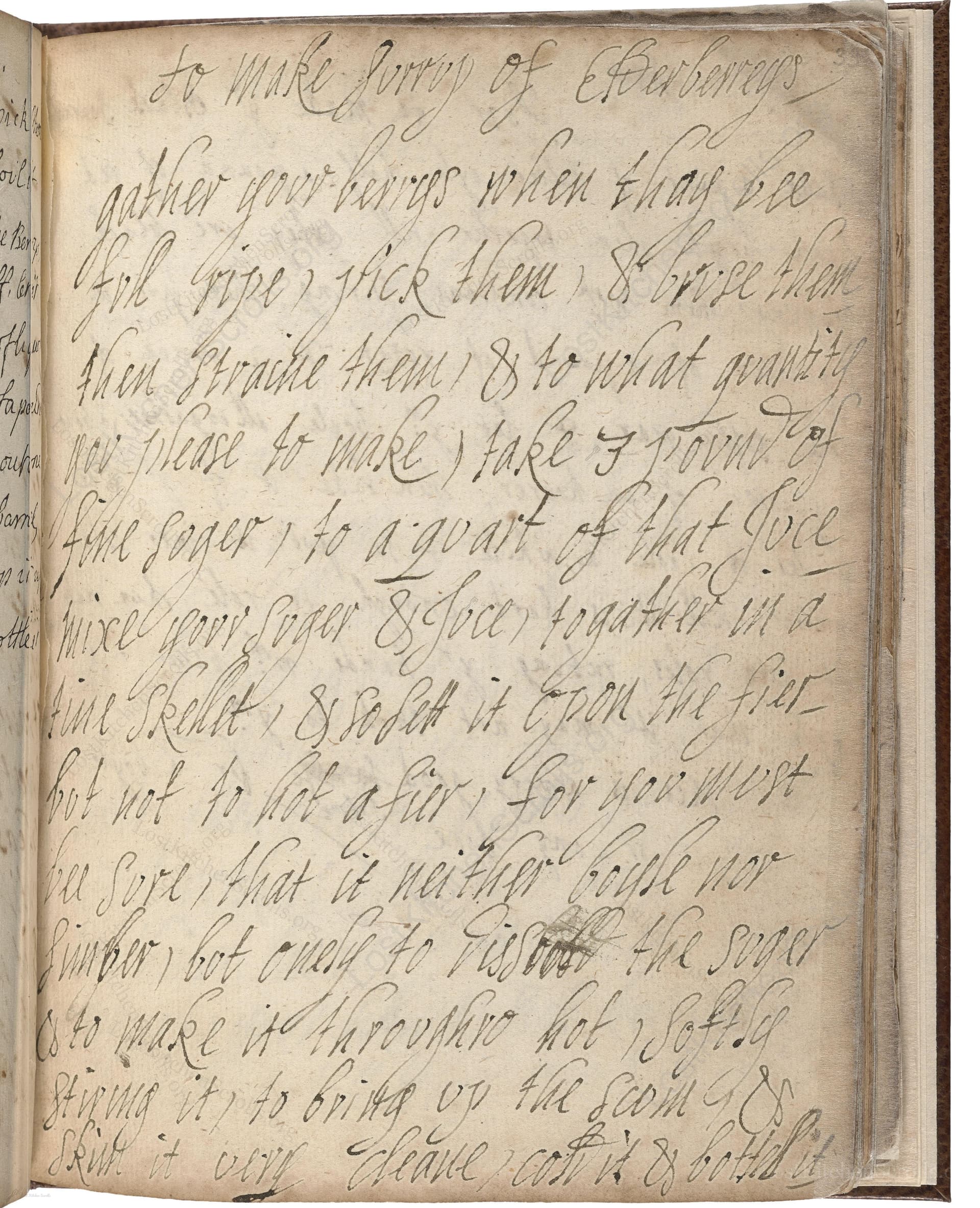
To Make Surrop Of Berberrys
"gather your berrys when thay bee full ripe, pick them, & brise them then straine them, & to what quantity you please to make, take 3 pound of fine suger, to a qvart of that Joce mixe your suger & Joce togather in a fine Skellet, & sett it Epon the fier but not to hot a fier, for you must bee Sure, that it neither boile nor simber, but onely to dissolve the suger & to make it throvghly hot, softly stiring it, to bring up the scom & skim it very cleane, cool it & bottle it"
Note on the Original Text
Recipes from this era are written as a set of practical instructions, assuming the reader already has some kitchen skill. Quantities are sometimes vague (“to what quantity you please to make”), placing agency with the cook. Spelling and grammar are flexible: for example, 'Surrop' stands for 'syrup,' 'Joce' for 'juice,' and 'Skellet' for 'skillet.' This manner of writing intentionally prioritizes process and observation over strict measurements, providing the experienced housewife or cook with the freedom to adapt based on available ingredients and tools.

Title
Cookery book of Lettice Pudsey, Seisdon, Staffordshire (1675)
You can also click the book image above to peruse the original tome
Writer
Lettice Pudsey
Era
1675
Publisher
Unknown
Background
Step into the 17th-century kitchen with Lettice Pudsey's delightful collection of recipes, where flavors, creativity, and tradition mingle to create a feast fit for Restoration-era tables. Expect a medley of hearty English fare, intriguing ingredient combinations, and a pinch of culinary wisdom from a bygone age.
Kindly made available by
Folger Shakespeare Library
This recipe, penned by Lettice Pudsey around 1675, hails from the golden age of English manuscript cookery, a time when households documented unique preserves and syrups to prolong the fleeting bounty of the garden. Barberries, now a rarity but then common in English hedgerows, were cherished for their tart flavor and medicinal qualities, often transforming into cordials for festive tables and sickrooms alike. Consuming, preserving, and recording recipes like this allowed families to demonstrate refinement, resourcefulness, and the ability to turn even the most humble berry into a culinary jewel.

In the 17th century, this syrup would be made using a heavy, hand-beaten brass or copper skillet (called a "skellet") set over a gentle hearth fire. The cook would use a wooden pestle to crush the berries and a fine muslin cloth (or hair sieve) for straining. Skimming was done with a simple wooden, horn, or pewter spoon, and the finished syrup was decanted into glass bottles sealed with parchment or cork.
Prep Time
30 mins
Cook Time
25 mins
Servings
20
We've done our best to adapt this historical recipe for modern kitchens, but some details may still need refinement. We warmly welcome feedback from fellow cooks and culinary historians — your insights support the entire community!
Ingredients
- 2.2 lbs ripe barberries (if unavailable, substitute red currants or cranberries for a similar tartness)
- 3 1/3 lbs white granulated sugar (for 1 quart of juice)
- Sterile water (as needed, if enough moisture is not released from the berries)
Instructions
- To create a vibrant Surrop (syrup) of barberries in your own kitchen, begin by collecting ripe, fresh barberries.
- Wash the berries and remove any stems.
- Crush the berries and strain them through a fine sieve or muslin cloth to extract their vivid, tangy juice.
- For every 1 quart of barberry juice, measure out 3 1/3 pounds of fine granulated sugar.
- Combine the juice and sugar in a heavy-bottomed saucepan.
- Gently heat the mixture over low heat, stirring frequently.
- Be careful—do not let it boil or even simmer; your goal is simply to fully dissolve the sugar and allow the syrup to become thoroughly hot.
- As froth (scum) rises to the top, skim it off with a spoon to keep the syrup clear.
- Once the sugar is completely dissolved and the syrup is smooth and hot, remove from heat.
- Let it cool, then pour into sterilized bottles.
- Store in the refrigerator and use as a cordial, mixer, or drizzle.
Estimated Calories
120 per serving
Cooking Estimates
Preparing Surrop takes time to wash, stem, crush, and strain the berries before slowly heating and dissolving the sugar into the juice. It also includes time for cooling before bottling. These times help you plan your kitchen work. The calorie number is for one serving of syrup when diluted for a drink, based on the total sugar used.
As noted above, we have made our best effort to translate and adapt this historical recipe for modern kitchens, taking into account ingredients nowadays, cooking techniques, measurements, and so on. However, historical recipes often contain assumptions that require interpretation.
We'd love for anyone to help improve these adaptations. Community contributions are highly welcome. If you have suggestions, corrections, or cooking tips based on your experience with this recipe, please share them below.
Join the Discussion
Rate This Recipe
Dietary Preference
Main Ingredients
Culinary Technique

Den Bockfisch In Einer Fleisch Suppen Zu Kochen
This recipe hails from a German manuscript cookbook compiled in 1696, a time whe...

Die Grieß Nudlen Zumachen
This recipe comes from a rather mysterious manuscript cookbook, penned anonymous...

Ein Boudain
This recipe comes from an anonymous German-language manuscript cookbook from 169...

Ein Gesaltzen Citroni
This recipe, dating from 1696, comes from an extensive anonymous German cookbook...
Browse our complete collection of time-honored recipes



